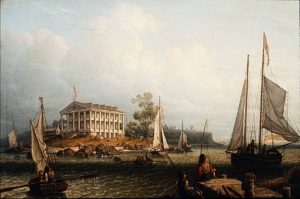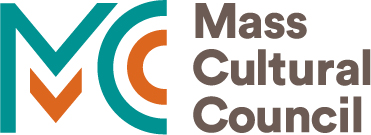Preventing the Virus “which walketh in darkness”: Rainsford Island, Paul Revere and the Board of Health

Rainsford’s Island, Boston Harbor, Robert Salmon, circa 1840
As the coronavirus quarantine continues in Boston and around the world, it is natural to feel uncertainty and anxiety. During this time, it makes sense to turn to history to further understand how Bostonians during the late-18th century grappled with epidemics, quarantine, and public health measures. While dozens of professionals like doctors, midwives, and medical apprentices healed their patients, entrepreneurs like Paul Revere also found ways to assist the medical community. Although Revere had several careers in the medical field, including dentist and coroner, his work as the first president of the Boston Board of Health best illuminates how previous Bostonians dealt with deadly epidemics in their own time.
When Paul Revere received his presidential appointment for the Board of Health in 1799, yellow fever was undoubtedly on his mind. Boston suffered bouts of the illness in each of the previous two years and the General Court feared an even larger outbreak, similar to what Philadelphia had experienced in 1793. Although it may seem odd that Revere was nominated for such a position despite his lack of medical education at such a critical moment, Board of Health members were selected based on their “standing as citizens” and were expected to “command the advice and assistance of physicians” as needed.
Although physicians debated the causes and cures for yellow fever, it was largely believed that the fever was caused by “putrid exhalations.” Rotting food, animal waste, refuse from tanners, and even “putrid puddles” were seen as harbingers of the virus. Just one month after the Board of Health’s formation, Revere and the other members crafted regulations to combat the fever. By April 1799, the Board published a list of “nuisances” that they believed could spread the fever, such as digging graves less than 6 feet below ground level. However, as physicians considered the virus’s physical spread, the Board required a second measure: ships arriving from foreign ports would have their crew and passengers inspected for any signs of illness. Any person with a suspected illness would then be quarantined on Rainsford Island in Boston Harbor. This island had been used in previous epidemics as a quarantine site, including the smallpox outbreak of 1763-4.
The Board of Health nominated Dr. Thomas Welsh, a Harvard-educated doctor trained during the American Revolution, to oversee medical care on the island, a role he continued in until 1825. As Dr. Welsh worked to heal sick patients on Rainsford Island, Paul Revere began to compile a report of the town’s success in halting yellow fever’s spread. By March 12, 1800, the Board of Health published a broadside detailing the efforts it had undertaken. The document demonstrates that the Board and physicians chose a two-pronged approach to combat the fever, since they were unsure if the epidemic came from “local or foreign causes.” Revere noted that the Board had removed many “nuisances” from the streets, including cleaning out “137 vaults of privies,” and removing “36 heaps of putrid substances” and “13 ponds and cellars of stagnant water.” These decisions were in fact helpful in slowing the spread of yellow fever, although at the time physicians did not understand exactly why. Revere and his contemporaries had unknowingly identified one of yellow fever’s causes, that stagnant water was a breeding ground for mosquitoes that transmitted the disease.
As in our contemporary crisis, the Board of Health’s public broadside noted that while most Bostonians followed the regulations despite “their novelty,” there were some individuals whose “passions could only be restrained by the terror of the Law.” Over the course of five months, the Board of Health had quarantined 195 different ships from around the world. The broadside listed the origins of these ships, demonstrating the extent that Boston’s economy depended on other countries. Out of the 26 countries listed, 14 were island colonies located in the Caribbean. Colonies like Barbados, Antigua and Jamaica produced staple items used in New England, including sugar, salt, coffee and cotton.
The broadside noted that while 1,820 individuals were quarantined on Rainsford Island, there were only three fatalities. This was attributed to “the attention of the visiting physician” as well as the “strict police” that kept “the crews of each vessel separate.” The broadside clarified that one fatality had been caused by smallpox, which was likely mentioned to quell rumors of a rising smallpox epidemic. In fact, the Board believed it was their “duty to declare that notwithstanding the idle reports too frequently spread by inconsiderate persons,” there had only been five cases of smallpox the previous summer. The broadside demonstrated the Board’s transparency, as they included a statement of their expenses for the year and how public health measures required coordination between Board members, citizens and laborers. The Board spent $457.50 on the Rainsford Island project, which they used to hire nurses and guards and to equip the island with “25 Red Flags and 1 Ensign.”
While Revere kept track of incoming ships, he also corresponded with officials in other seaport cities in the United States. When these cities reported an outbreak, Revere and the Board would quarantine all ships arriving from that city. In addition, taverns and innkeepers in Massachusetts were required to notify the Board of Health if one of their traveling guests became ill. As he had during the period before the Revolutionary War, Revere was able to use his social and political connections to organize a public health initiative at another moment of crisis in Boston’s history. In doing so, his coordination and communication with different cities and countries was incredibly far-reaching. Revere’s role as president of the Board thus debunks the notion that his world was more isolated than our connected world today. As in our contemporary battle against the coronavirus, citizens of Boston had to work together to combat the spread of yellow fever.
Nina Rodwin is an interpreter at the Paul Revere House.




